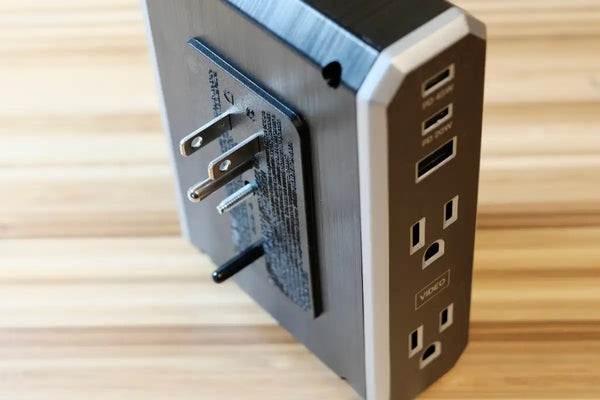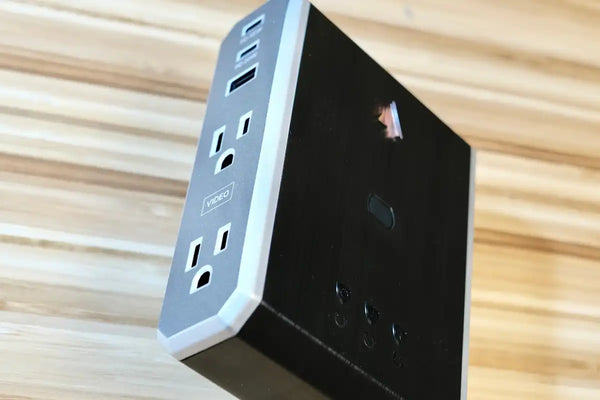Austere VII Series Power 4-Outlet Review: Compact Surge Protection
Austere packages several kinds of promises into its new VII Series surge protector: reduction of electrical interference that produces worse audio or affects video, an extremely tight control of surges with built-in protection, and providing extra AC outlets and three medium-wattage USB ports. The company bets you’ll want all of that in a single package you’re not embarrassed to attach to your wall.
This review is part of TechHive’s in-depth coverage of the best surge protectors.
The surge protector’s design requires that you cover an existing two-AC plug wall outlet, using a screw as additional leverage. The screw has a rubber cover, one of many aesthetic touches. The VII Series has two AC outlets on its left-hand side marked Video, and two on the right marked Audio. The intent is that you separate your receiver, TV, and other sources to make use of built-in signal filtering that can improve the quality in some particularly noisy electrical environments. (Outside of lab conditions with artificial noise generators, it’s hard to test how much this affects modern digital equipment.)

Two USB-C and one USB-A jacks are on the left-hand side of the multi-outlet unit. The USB-C ports are rated at 45 watts and 20W, respectively; if both are in use, they share the maximum 45W output. The USB-A jack has its own feed, which Austere notes as 2.4 amps, but translates into 12W of power at 5 volts, the standard Type-A voltage.
As a surge protector, Austere uses metal oxide varistors (MOVs), a common circuit type used by all but super-expensive surge protectors to absorb excess voltage during power surges. The MOVs burn through a built-in capacity over time. There’s no way to know how long MOVs will last, however, because you would need to know precisely the level of power surges you anticipate and their duration in the future to predict that. Generally, you want more surge protection and higher rating in joules (overall surge-absorption capacity) if you’re in an area with frequent power overages.

Austere has chosen a very low surge-protection level, called the clamping voltage, of 280 volts. Many competing devices clamp above 330V, 500V, or even 700V. In practice, it’s hard to know which voltage is too high to protect gear—500V seems like the maximum you’d want to risk, and a lower number has a greater likelihood of reducing wear on your hardware’s power supply. A lower clamping voltage, however, also means that MOVs could wear out more quickly, requiring you to replace the entire unit.
The VII Series has three lights on its front to help you understand its status. From left to right, it’s power, proper grounding status, and surge protection. If the outlet the Austere is plugged into isn’t grounded, that light won’t illuminate, and you should contact an electrician. When surge protection is exhausted—the MOVs are fully burned out—the third light will disappear. Austere has made the choice, like many manufacturers, to keep electricity flowing even when protection ends. You’ll need to keep an eye on it if surges are a regular concern. The product’s design, however, makes this easy to spot.

We reviewed the VII Series model, the highest-end model. The lower-end and less-expensive III ($79.99) and V ($99.99) Series offer reduced electrical noise filtration, though described in vague enough terms to not be much of a feature difference. The V offers less power over its three USB jacks and the III has just one USB-C and one USB Type-A port with lower power. The two lower-end units also sport fewer joules for surge protection, meaning they might burn through their available MOVs clamping more quickly in areas with lots of surges.
The bottom line It’s hard to argue with the Austere VII Series as a good choice based on features. The relatively high price might discourage you unless you have a specific problem that it solves: if you want four outlets and three USB jacks in a compact space, have electrical-based noise that interferes with your existing A/V equipment, or want heavy surge protection. For any of those three, the Austere justifies its design and price. If none of those criteria fit you, however, seek a more traditional surge protector with more outlets and a cord.



